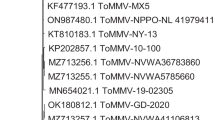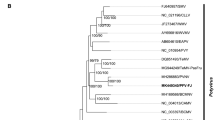Abstract
The complete genomic sequence of Habenaria mosaic virus (HaMV), which infects terrestrial orchids (Habenaria radiata), has been determined. The genome is composed of 9,499 nucleotides excluding the 3′-terminal poly(A) tail, encoding a large polyprotein of 3,054 amino acids with the genomic features typical of a potyvirus. Putative proteolytic cleavage sites were identified by sequence comparison to those of known potyviruses. The HaMV polyprotein showed 58 % amino acid sequence identity to that encoded by the most closely related potyvirus, tobacco vein banding mosaic virus. Phylogenetic analysis of the polyprotein amino acid sequence and its coding sequences confirmed that HaMV formed a cluster with the chilli veinal mottle virus group, most of which infect solanaceous plants. These results suggest that HaMV is a distinct member of the genus Potyvirus.


Similar content being viewed by others
References
Abascal F, Zardoya R, Posada D (2005) ProtTest: selection of best-fit models of protein evolution. Bioinformatics 21:2104–2105
Adams MJ, Antoniw JF, Beaudoin F (2005) Overview and analysis of the polyprotein cleavage sites in the family Potyviridae. Mol Plant Pathol 6:471–487
Adams MJ, Antoniw JF, Fauquet CM (2005) Molecular criteria for genus and species discrimination within the family Potyviridae. Arch Virol 150:459–479
Adams MJ, Zerbini FM, French R, Rabenstein F, Stenger DC, Valkonen JPT (2011) Family Potyviridae. In: King AMQ, Adams MJ, Carstens EB, Lefkowitz EJ (eds) Virus taxonomy: ninth report of the international committee on taxonomy of viruses. Elsevier, New York, pp 1069–1089
Chiba S, Kondo H, Tani A, Saisho D, Sakamoto W, Kanematsu S, Suzuki N (2011) Widespread endogenization of genome sequences of non-retroviral RNA viruses into plant genomes. PLoS Pathog 77:e1002146. doi:10.1371/journal.ppat.1002146
Chung BYW, Miller WA, Atkins JF, Firth AE (2008) An overlapping essential gene in the Potyviridae. Proc Natl Acad Sci USA 105:5897–5902
Darriba D, Taboada GL, Doallo R, Posada D (2012) jModelTest 2: more models, new heuristics and parallel computing. Nat Methods 9:772
Gara IW, Kondo H, Maeda T, Tamada T, Inouye N (1997) Stunt disease of Habenaria radiata caused by a strain of watermelon mosaic virus 2. Ann Phytopathol Soc Jpn 63:113–117
Gibbs A, Ohshima K (2010) Potyviruses and the digital revolution. Ann Rev Phytopathol 48:205–223
Guindon S, Gascuel O (2003) A simple, fast, and accurate algorithm to estimate large phylogenies by maximum likelihood. Syst Biol 52:696–704
Guindon S, Dufayard JF, Lefort V, Anisimova M, Hordijk W, Gascuel O (2010) New algorithms and methods to estimate maximum-likelihood phylogenies: assessing the performance of PhyML 3.0. Syst Biol 59:307–321
Inouye N, Maeda T, Mitsuhata K, Gara IW (1998) Habenaria mosaic potyvirus, a new member of potyvirus from Habenaria radiata orchid. Bull Res Inst Bioresour Okayama Univ 5:155–168
Katoh K, Toh H (2008) Recent developments in the MAFFT multiple sequence alignment program. Brief Bioinform 9:286–298
Kondo H, Chiba S, Toyoda K, Suzuki N (2013) Evidence for negative-strand RNA virus infection in fungi. Virology 435:201–209
Kozak M (1989) The scanning model for translation: an update. J Cell Biol 108:229–241
Lopez-Moya JJ, Wang RY, Pirone TP (1999) Context of the coat protein DAG motif affects potyvirus transmissibility by aphids. J Gen Virol 80:3281–3288
Martin DP, Lemey P, Lott M, Moulton V, Posada D, Lefeuvre P (2010) RDP3: a flexible and fast computer program for analyzing recombination. Bioinformatics 26:2462–2463
Mitsukuri K, Arita T, Johkan M, Yamasaki S, Mishiba K, Oda M (2009) Effects of type of explant and dark preconditioning on bud formation in Habenaria radiata (Thunb.) in vitro. Hortscience 44:523–525
Rabelo FDC, Nicolini C, Resende RD, de Andrade GP, Pio-Ribeiro G, Nagata T (2013) The complete genome sequence of a Brazilian isolate of yam mild mosaic virus. Arch Virol 158:515–518
Talavera G, Castresana J (2007) Improvement of phylogenies after removing divergent and ambiguously aligned blocks from protein sequence alignments. Sys Biol 56:564–577
Turpen T (1989) Molecular cloning of a potato virus Y genome : nucleotide sequence homology in non-coding regions of potyviruses. J Gen Virol 70:1951–1960
Urcuqui-Inchima S, Haenni AL, Bernardi F (2001) Potyvirus proteins: a wealth of functions. Virus Res 74:157–1755
Acknowledgments
We are grateful to Kouji Mitsuhata for technical assistance. We thank Dr. Narinobu Inouye for helpful advice. This work was partially supported by a Grant-in-Aid for Scientific Research [KAKENHI] from the Japanese Ministry of Education, Culture, Sport, Science and Technology, and by Yomogi Inc.
Author information
Authors and Affiliations
Corresponding author
Electronic supplementary material
Below is the link to the electronic supplementary material.
Rights and permissions
About this article
Cite this article
Kondo, H., Maeda, T., Gara, I.W. et al. Complete genome sequence of Habenaria mosaic virus, a new potyvirus infecting a terrestrial orchid (Habenaria radiata) in Japan. Arch Virol 159, 163–166 (2014). https://doi.org/10.1007/s00705-013-1784-6
Received:
Accepted:
Published:
Issue Date:
DOI: https://doi.org/10.1007/s00705-013-1784-6




